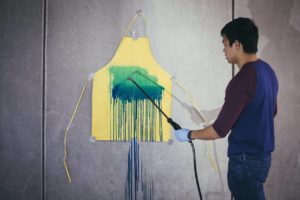Columbia students develop a powder that turns bleach blue to ensure fully sterilized suits
By ZOLAN KANNO-YOUNGS
May 26, 2016 6:05 p.m. ET
Hours before they graduated last week, three Columbia University students were bottling their concoction in a campus laboratory, preparing it for a crucial field test overseas.
On Saturday, Jason Kang, Katherine Jin and Kevin Tyan are scheduled to travel to West Africa—for the second time in six months—to gather feedback for a solution they made to combat Ebola.
They have developed a powder that colorizes disinfecting bleach, which is used to cleanse the suits of those working near infectious diseases before they take them off. Because bleach is transparent, it is difficult to know if the uniform has been sterilized.
Kinnos Highlight is mixed into a container that can be used to spray bleach on the suits of health-care workers. ENLARGE
Kinnos Highlight is mixed into a container that can be used to spray bleach on the suits of health-care workers. PHOTO: JOHN TAGGART FOR THE WALL STREET JOURNAL
“It’s impossible to guarantee complete coverage using bleach,” Mr. Kang said last week. “The original idea was to maybe have a suit that would color each time you hit it.”
But Mr. Tyan had a more practical idea: creating a powder that turned bleach blue. They dubbed the powder, “Highlight.”
“That was really the aha moment,” Mr. Kang said.
The blue fades over time, signaling when it is safe to touch a suit. The powder also slows down the bleach’s evaporation time, making it more effective in hot weather.
The three started working on the idea in 2014, when Columbia challenged its students to design something that could help people battling the Ebola epidemic. Mr. Kang, a 22-year-old biomedical engineer, said they knew many health-care workers were contaminated with the virus because they couldn’t adequately disinfect their suits. According to a World Health Organization report, there were 815 “confirmed and probable” cases of health-care workers being infected with Ebola between January 2014 and March 2015 in Sierra Leone, Liberia and Guinea.
Health-care workers and government officials dealing with hazardous materials and infectious diseases are supposed to spray bleach on their suits.
Mr. Kang, Ms. Jin and Mr. Tyan were finalists in the Columbia design competition, achieved recognition on campus and caught the attention of an alumnus working at the Fire Department of New York.
The department’s first responders to hazardous environments also need to decontaminate their suits with bleach. David Prezant, FDNY’s chief medical officer, noticed there was no way to be sure bleach was getting all over workers’ uniforms.
Dr. Prezant recalled bringing the three students to Staten Island on a frigid night to demonstrate their invention.
“It doesn’t matter whether you’re a 20-year-old or a 40-year-old,” he said. “If you got a good idea, we’re going to listen.”
Kevin Tyan, Katherine Jin and Jason Kang created Kinnos Highlight. ENLARGE
Kevin Tyan, Katherine Jin and Jason Kang created Kinnos Highlight. PHOTO: JOHN TAGGART FOR THE WALL STREET JOURNAL
Dr. Prezant said the firefighters mixed the powder with the bleach and were impressed when they saw the liquid they were spraying was bright blue. They grew concerned, though, when the liquid froze because of the cold weather.
The three subsequently altered the formula of the solution so it could better handle extreme weather.
“They could’ve said, ‘We’re a bunch of kids, we’ll think about this in a few months,’” Dr. Prezant said. “But they didn’t.”
The department bought about 200 bottles of Highlight for $10 each and implemented it into their training protocol for squads that deal with hazardous materials.
The trio founded a company, Kinnos, and plan to work on their new venture full time out of a startup lab at the university for alumni. They said they have received interest from health centers throughout the country and some international organizations.

The three won multiple awards in 2015, including a grant for more than $500,000 from the U.S. Agency for International Development, which works to end poverty world-wide.
The students used part of the federal grant to fly to Liberia last November to train health-care workers on how to use their product. They said the workers often didn’t thoroughly decontaminate themselves either because they didn’t have an adequate concentration of bleach or they were rushing to their next task.
“We put on the suits and it was just suffocating,” said Mr. Tyan, noting that these workers were in the uniforms for four to five hours at a time. “It is very understandable that you would want to take your suit off as soon as possible.”
Francois de la Roche, country director in Guinea for the International Medical Corps, a global nonprofit, said Guinea is in a “recovery period” and his workers are conducting survivor care and surveillance for any potential outbreaks.
GET GREATER NEW YORK NEWS ALERTS
Sign up here to receive e-mail alerts for breaking news and exclusive stories from The Wall Street Journal’s Greater New York section.
He said the trio must be cautious during their visit not to bring something too foreign to the rural community.
“If we come in to, say, their village and start spraying the village bright blue or bright yellow, they may think we’re doing something that’s going to permanently affect them so we want to be real careful,” he said.
But Mr. de la Roche said he is confident Highlight can be an asset.
“If this is a great innovation that makes it easier for us to help people,” he said, “by golly, let’s use it.”

